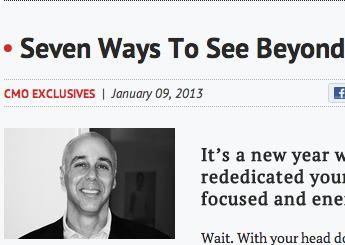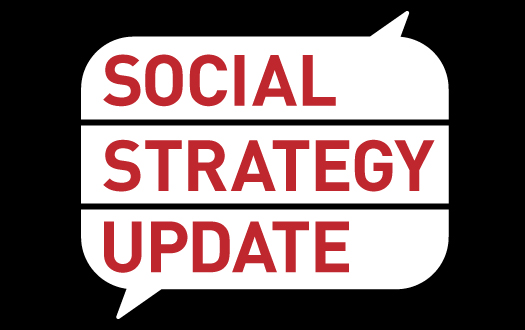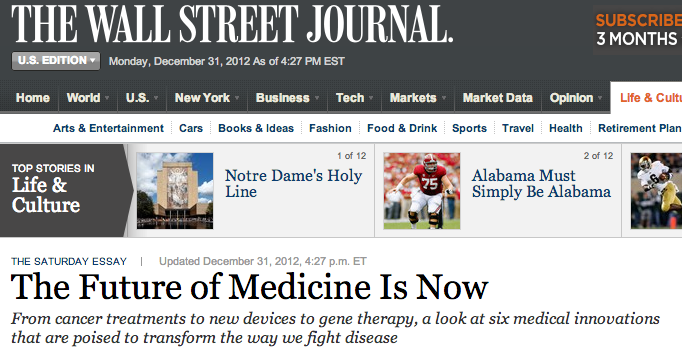By
Team DIGO | 01/10/2013 | in

Jeff Pundyk, CMO.com
It’s a new year with new goals, and you have rededicated yourself to driving results. You are focused and energized. Head down.
Wait. With your head down, you just might miss the signs of change, the subtle shifts that signal that your customers are operating in a different way, that competition is coming from someplace unexpected, that the nature of your opportunity has changed.
As the pace of change continues to accelerate, the task of keeping up should be part of your job description. Here are a few simple ways to look beyond the next quarter:
Get out of the building: Dedicate 20 percent of your time to talking to people doing things differently than you. Look outside of your industry, find people who work at different stage companies, and seek out those doing things that conventional wisdom says probably won’t work for you. Talk to your company’s alumni. No agenda. Just ask good questions, listen, and learn.
Read the full article here.
By
Team DIGO | 01/08/2013 | in
People get ahead of advertisers, and when they do there is opportunity for change agents like you to seize advantage.
In this case, a few words from the very smart to the wise should be sufficient to get some productive conversations going.
Mary Meeker of venture capital firm Kleiner Perkins analyzed the percentage of time spent on each medium and compared it to ad spend. She found consumers spend 26% of their media consumption time online, while marketers spend 22% of their ad budgets on digital. TV should fare better, with consumers spending 43% of their media time watching TVand marketers spending 42% of their ad budgets on the thing we used to call the “tube.” Mobile is the area best poised for geometric growth, as consumers are now spending 10% of their time with mobile, while marketers are only spending a wee 1% of their ad budgets there.
Print once again looks like the big loser. Consumers spend 7% of their media consumption time with print, while marketers spend 25% of their ad budgets in print.
One further word to the wise: Think about the implications not just for your paid media, but for owned and earned media as well.
Now, let’s make some change!
Read more about Mary Meeker’s analyzation here.
By
Team DIGO | 01/08/2013 | in

DIGO client AliveCor has been featured in many publications subsequent to the recent announcement of FDA approval for their life-changing heart monitor device. The AliveCor Heart Monitor makes it easy to do a medical quality ECG with an iPhone. The most recent article is in the Washington Post, as an innovation prediction for a growing mobile health category in 2013. Read the full article here.
By
Team DIGO | 01/07/2013 | in

1. New Scam Targets Facebook Page Owners
2. How to Follow CES 2013 Online
3. Does Your Brand Have a Social Media Blind Spot? (Infographic on Reputation Management—Check it out!)
4. TV Shows and Movies With Most Engaged Fans on GetGlue
5. Reddit Rumored To Be Raising Money, $400 Million Valuation
6. Dating Website “High Season” Means More Fish in the Sea
7. Viral Content:
Amazing Facts to Blow Your Mind
Five Guys Burger Review— “Oh My Dayum” (Auto Tuned)
Mistletoe Kissing Prank
By
Team DIGO | 01/07/2013 | in
I wrote this little system to help my twelve year olds write their school assignments, then took a look at it and realized it would work pretty well for you and me too. Enjoy!
1) Talk it out. Find a subject that really interests you. Play around with a few different “points to prove” until you come up with one that really excites you.
2) Write down your main point. Make sure you’ve really stated it clearly and well.
3) Do your research. Fill out your sheet with more than enough supporting evidence. Go beyond the source material. Use the Internet as well. Find interesting connections to your subject.
4) Write a draft. Start with your “thesis statement” – the point you aim to prove – and write out your essay. Don’t worry, just write. Write fast. Write stupid stuff. Write long. Write until finished without looking back.
5) Now read what you wrote. Notice what is working and what isn’t. What’s missing? What’s out of order? Do you have a good beginning, middle and end? Make good notes on the page. Cross out things you want to delete. Write in things you want to add.
6) Now revise. First get the order right. Then the sentences. Then work on the transitions. Finally read it through and make any changes to make it sound good from beginning to end.
7) Now proof read. Always have someone else read it too and mark up grammatical and spelling errors, but only after you’ve done your best to find and correct everything.
8) Correct and print!
9) Get credit. Make a plan for remembering to turn it in.
By
Team DIGO | 01/04/2013 | in
So, by now you know I’m obsessed with reframing. In short, it goes like this: Your brain is a lazy piece of meat, it needs to be shocked into seeing things differently!
I absolutely love these classic movies and each one of them is all about reframing. If you want to become a master of changing perceptions, do as I do and watch them again and again. It’s fun work.
1) A Christmas Carol. Charles Dickens classic employs the ghosts of past, present and future to change an old man’s mind, which changes his life. Get to know it like the back of your hand.
2) It’s a Wonderful Life. “I wish I never lived.” So says George Bailey, the hero of this classic Capra film that opens with a suicide attempt. The rumpled angel who overhears this replies, “Yes… Yes! It’s perfect!!” And he’s right, of course. Seeing the world as it would be if Bailey had never been born turns out to be an extraordinarily powerful reframing device that changes his mind and his life. Also, bells ring.
3) The Wizard Of Oz. From “I’ve got to get out of this place!” to “There’s no place like home!” A tornado, two witches, a wizard and a road. A classic of reframing. And the music is beautiful too.
4) Groundhog Day. A gorgeous and elegant concept. Bill Murray’s character lives the same day over and over again until he gets it right. The process radically changes his perceptions of himself, his life, a small town in Pennsylvania and the value of people.
5) The Game. David Fincher’s classic – underappreciated when it was released — starring a terrific Michael Douglas as Nicholas Van Orton is an extraordinary film all about the power for reframing. The man who has everything needs only a new mindset. That’s what The Game is for.
I’m fascinated by stories of changing perceptions changing lives, and these are some of the best on film. As a crafter of perceptions, this is an appropriate occupational obsession. As a human being, I’ve learned to use reframing to keep myself motivated, directed and generally pretty happy through the vicissitudes of life. Advertising to myself is a key to that. This is my ongoing attempt to share that key with you. Enjoy!
By
Team DIGO | 01/04/2013 | in
Things I believe:
1) You’re wealthy. If you are not freezing in your own house in the winter, if half of your 17 kids didn’t fail to survive to adulthood, if you can warm up and charge up in a public library and get treated in a modern emergency room, if you have access to antibiotics, then you are like a God compared to the robber barons of a century ago. Deal with it.
2) Changing Perceptions Matters More Than Changing Reality. Today, your kids are safer in school, you’re likely to live about twice as long, and you’re considerably richer than people were at about the time I was born. But you don’t necessarily feel it.
3) Reframing Is The Key to Changing Perceptions. Advertising helps you buy feelings wrapped in new frames of reference along with your products. It’s typically not the products that add the value – it’s the frames. Really. People don’t buy the products, they buy the feelings. My work is measured and tested against other work. I’m here to tell you that this stuff is true because it works.
4) Reframing is About Seeing Things In a Different Way and You Can Do It To Yourself. Think about this – you don’t need the product. You can make your own frame, or just enjoy the frame from the ad and leave the product right where it is. (Of course, as an ad guy I enjoy when you reward my clients with your custom, so feel free to buy ;-) But… you can advertise to yourself! Look around – advertising works! Don’t you have some things you want to sell yourself today?
I’ll be writing a lot more about reframing to change your own perceptions and I’ll be working on ways to help you do it more effectively. Watch this space ;-)
By
Team DIGO | 01/04/2013 | in

When you represent real news, the hard part is keeping up. Everyone is writing about The AliveCor Mobile Heart Monitor, because the recently FDA-approved mobile health marvel represents a revolution in healthcare. DIGO is the brand and business building partner for AliveCor, doing everything from branding and design, to marketing strategy, advertising to professionals and the public, public relations and social, while Proove does the media and optimizations. Read what the Wall Street Journal has to say here.






